Ivermectin Topical for Rosacea: Why More People Are Switching to This Treatment
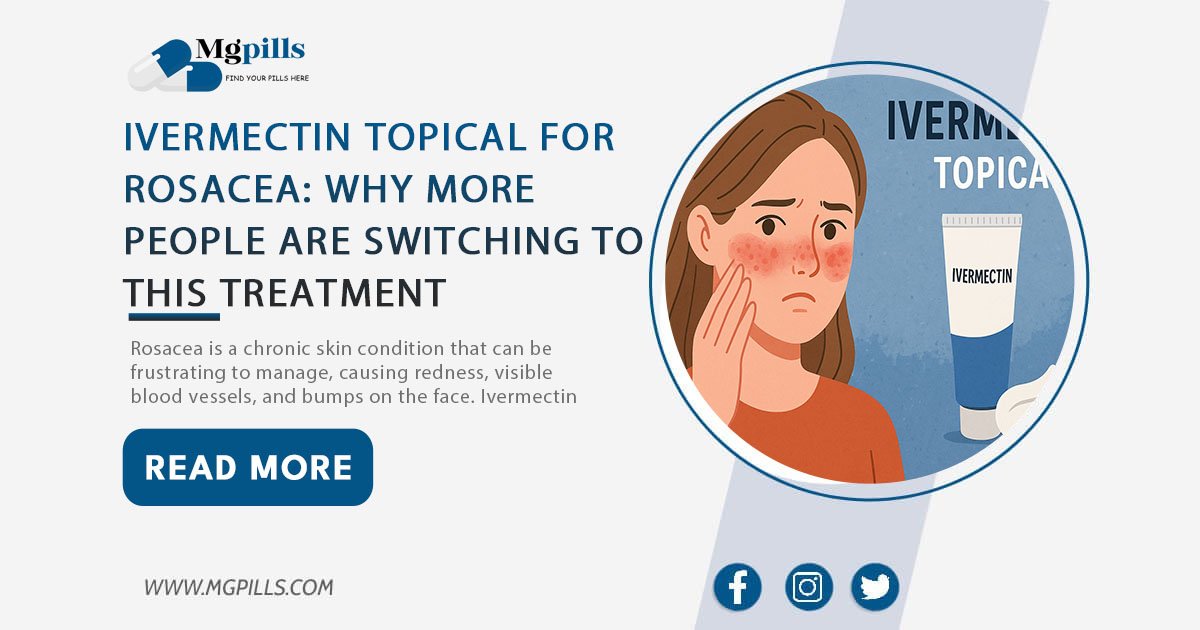
Rosacea is a chronic skin condition that can be frustrating to manage, causing redness, visible blood vessels, and bumps on the face. Ivermectin topical for rosacea has emerged as a breakthrough topical treatment, offering targeted relief where other creams or antibiotics may fall short.
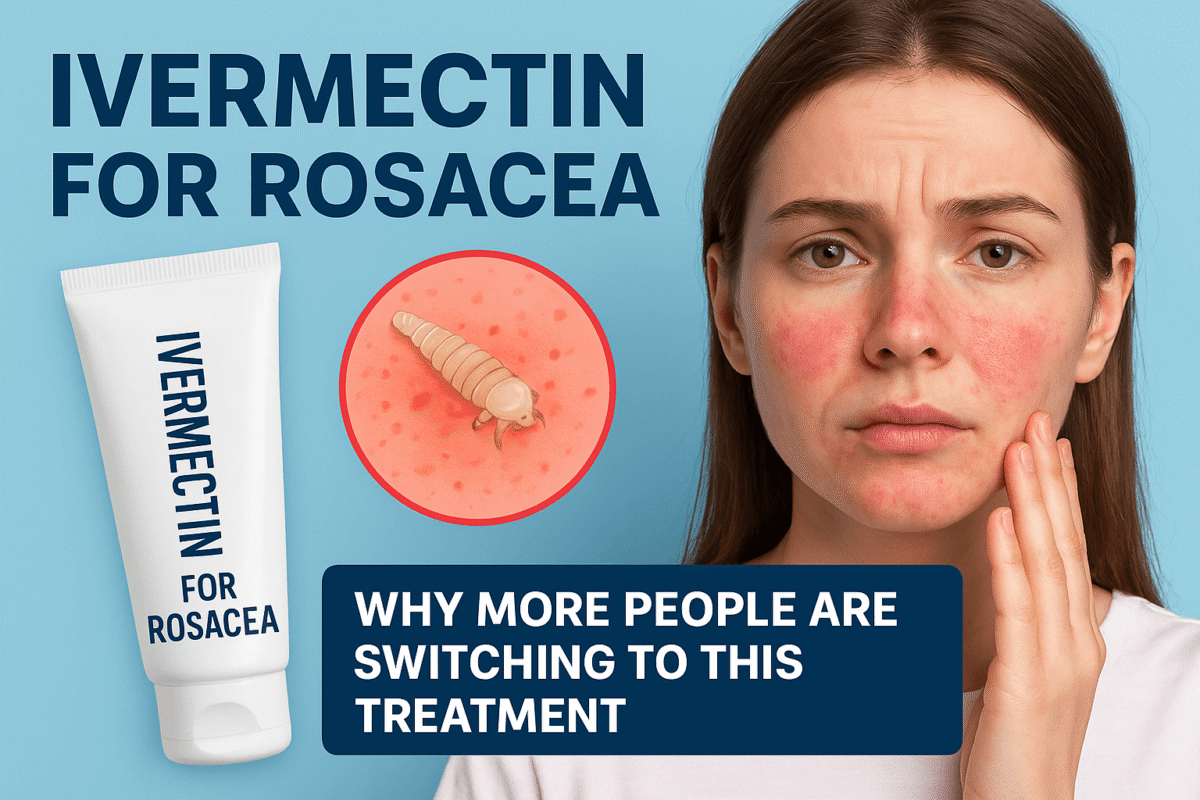
Here’s why it’s gaining attention:
- Targets the root cause: Ivermectin topical creams reduce microscopic mites (Demodex) linked to rosacea flare-ups.
- Reduces inflammation: Helps calm redness, swelling, and papules for clearer skin.
- Fast and visible results: Many patients notice improvement within 2–4 weeks.
- Gentle on sensitive skin: Less irritation compared to some antibiotics or harsh topical treatments.
- Available options: Branded Soolantra cream or generic ivermectin 1% cream (ivermectin cream 1, ivermectin 1 topical cream).
- Improves quality of life: Clearer skin enhances confidence and emotional well-being.
In this guide, we’ll dive deeper into how ivermectin for rosacea works, its effectiveness, safety, and why more patients are switching to this innovative topical treatment.
What Is Ivermectin Topical?
Ivermectin topical is a 1% cream approved by the FDA for treating rosacea, particularly the papulopustular subtype characterized by red, swollen bumps on the face. Unlike oral ivermectin, which is used to treat internal parasitic infections, the topical form is applied directly to the skin, allowing it to target the affected areas more effectively.
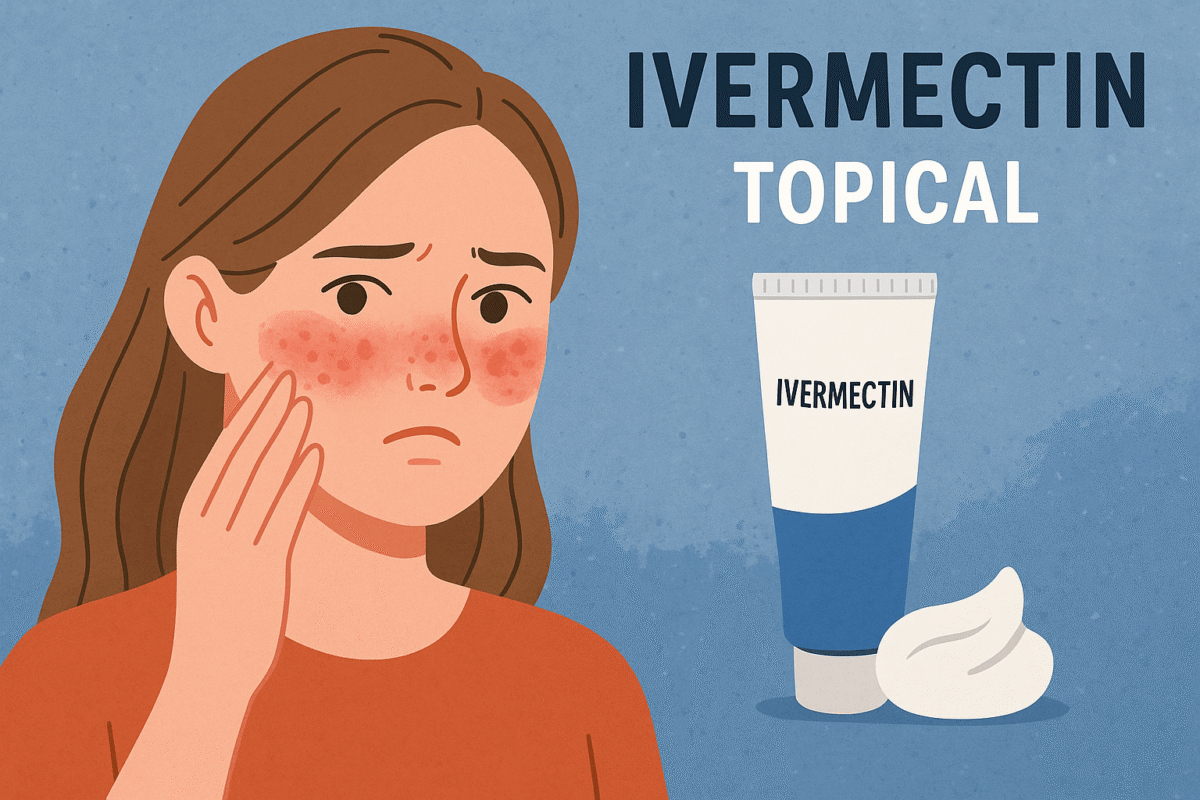
Different Names, Same Active Ingredient
You may encounter this medication under various names:
- Ivermectin 1% Cream
- Ivermectin Cream 1
- Ivermectin 1 Topical Cream
Despite the different names, they all contain the same active ingredient and are used to treat rosacea.
How It’s Different From Oral Ivermectin
Some people take ivermectin as a pill for parasites inside the body. But for rosacea, the cream works best because you put it directly on your skin. This way, it works faster, is gentler, and targets the red bumps right where they are.
How It Works
The exact mechanism of action of ivermectin topical in treating rosacea is not fully understood. However, it is believed to work through a combination of:
- Anti-inflammatory effects: Reducing redness and swelling associated with rosacea.
- Antiparasitic effects: Targeting Demodex mites, microscopic organisms that are more prevalent in individuals with rosacea and may contribute to the condition’s symptoms.
Clinical Evidence
A study published in the Journal of the European Academy of Dermatology and Venereology in 2017 investigated the dual action of ivermectin 1% cream in treating rosacea. The study found that the cream significantly reduced the density of Demodex mites and decreased the expression of inflammatory markers in the skin, leading to clinical improvement in patients with rosacea
How Ivermectin Works on Rosacea
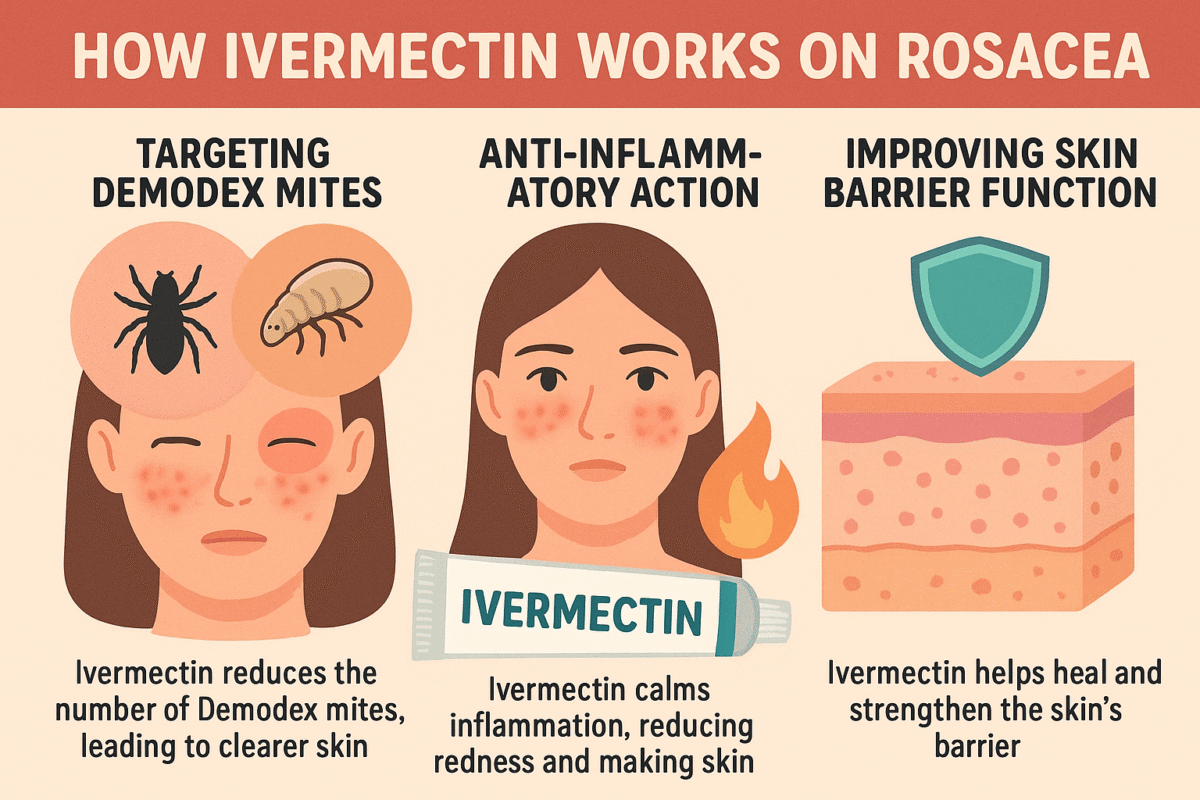
🐜 Targeting Demodex Mites
Imagine tiny bugs called Demodex mites living on your skin. They’re usually harmless, but in people with rosacea, there can be too many of them. These mites can cause the skin to get red and bumpy. Ivermectin topical helps by reducing the number of these mites, leading to clearer skin.
A study published in the Journal of Investigative Dermatology found that ivermectin 1% cream not only decreased the number of Demodex mites but also changed the types of bacteria on the skin, promoting a healthier balance. This suggests that ivermectin may help improve rosacea by both reducing mite populations and supporting beneficial bacteria on the skin.
🔥 Anti-Inflammatory Action
When the skin gets irritated or inflamed, it can become red and swollen. Ivermectin topical helps calm this inflammation, reducing redness and making the skin feel better. This is especially important for people with papulopustular rosacea, a type that causes red bumps and pimples on the face.
Research has shown that ivermectin 1% cream significantly reduces the redness and bumps associated with rosacea. In a study published in the Journal of the European Academy of Dermatology and Venereology, patients treated with ivermectin cream experienced a significant decrease in rosacea symptoms.
🛡️ Improving Skin Barrier Function
The skin acts as a protective barrier, and when it’s damaged, it can become more sensitive and prone to irritation. Ivermectin topical helps by reducing inflammation, allowing the skin to heal and become less sensitive over time. This leads to healthier skin that can better protect itself.
A study published in Acta Dermato-Venereologica found that ivermectin 1% cream improved the skin’s barrier function in patients with rosacea. The treatment led to a reduction in inflammation and an improvement in skin barrier integrity.
Soolantra vs. Ivera Cream: Why More Patients Prefer Ivera
What Is Ivera Cream?
Ivera Cream is a high-quality ivermectin 1% topical cream, formulated to treat rosacea symptoms such as redness, swelling, and bumps. It offers fast-acting relief and is trusted by many dermatologists and patients worldwide.
Why Ivera Cream Stands Out
While branded Soolantra contains the same active ingredient, Ivera Cream offers:
- Affordable pricing without compromising quality.
- Consistent formulation for effective, reliable results.
- Fast visible improvement in redness, bumps, and skin texture.
- Dermatologist-trusted quality and globally shipped availability.
Comparison Table: Ivera Cream vs Soolantra Cream
| Feature | Ivera Cream | Soolantra Cream |
| Active Ingredient | Ivermectin 1% | Ivermectin 1% |
| FDA Approval | Generic-equivalent; clinically effective | Branded, FDA-approved |
| Price | More affordable | Higher cost |
| Patient Feedback | Fast results, less irritation | Effective, slightly slower results |
| Dermatologist Trusted | ✅ Yes | ✅ Yes |
| Availability | Worldwide shipping, ready stock | Limited availability in some regions |
| Skin Tolerance | Gentle, suitable for sensitive skin | Gentle, but higher price |
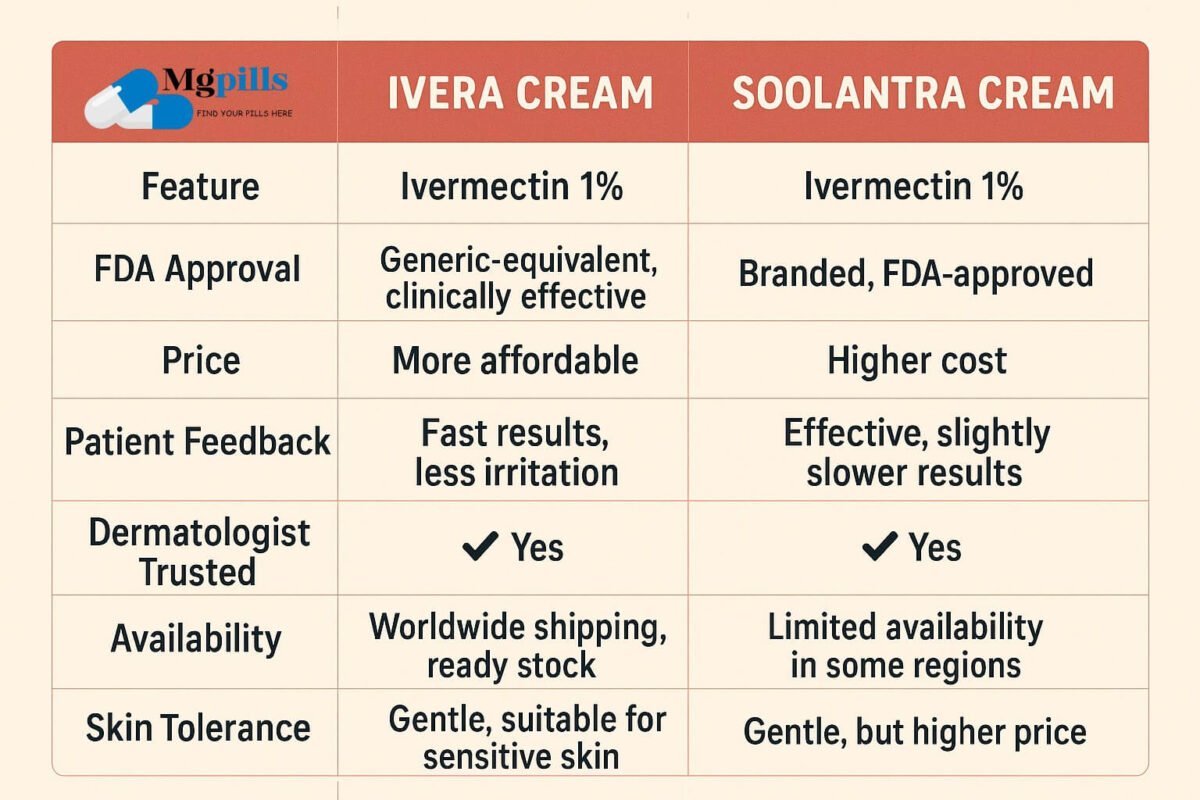
Patient Experiences With Ivera Cream
Many users report noticeable improvement within 2–3 weeks, with reduced redness, smoother skin, and greater confidence. Compared to Soolantra, Ivera Cream provides the same active ingredient and effectiveness at a lower price, making it a smarter choice for long-term rosacea management.
Most Important :
For affordable, reliable, and dermatologist-approved rosacea treatment, Ivera Cream is the preferred option. It combines the benefits of Soolantra with better accessibility and value, helping patients achieve clearer skin without breaking the bank.
Ivermectin Topical vs. Other Rosacea Treatments (Antibiotics, Metronidazole, Azelaic Acid)
When it comes to treating rosacea, there are multiple options available. However, Ivermectin topical creams like Ivera Cream offer unique advantages over traditional treatments.
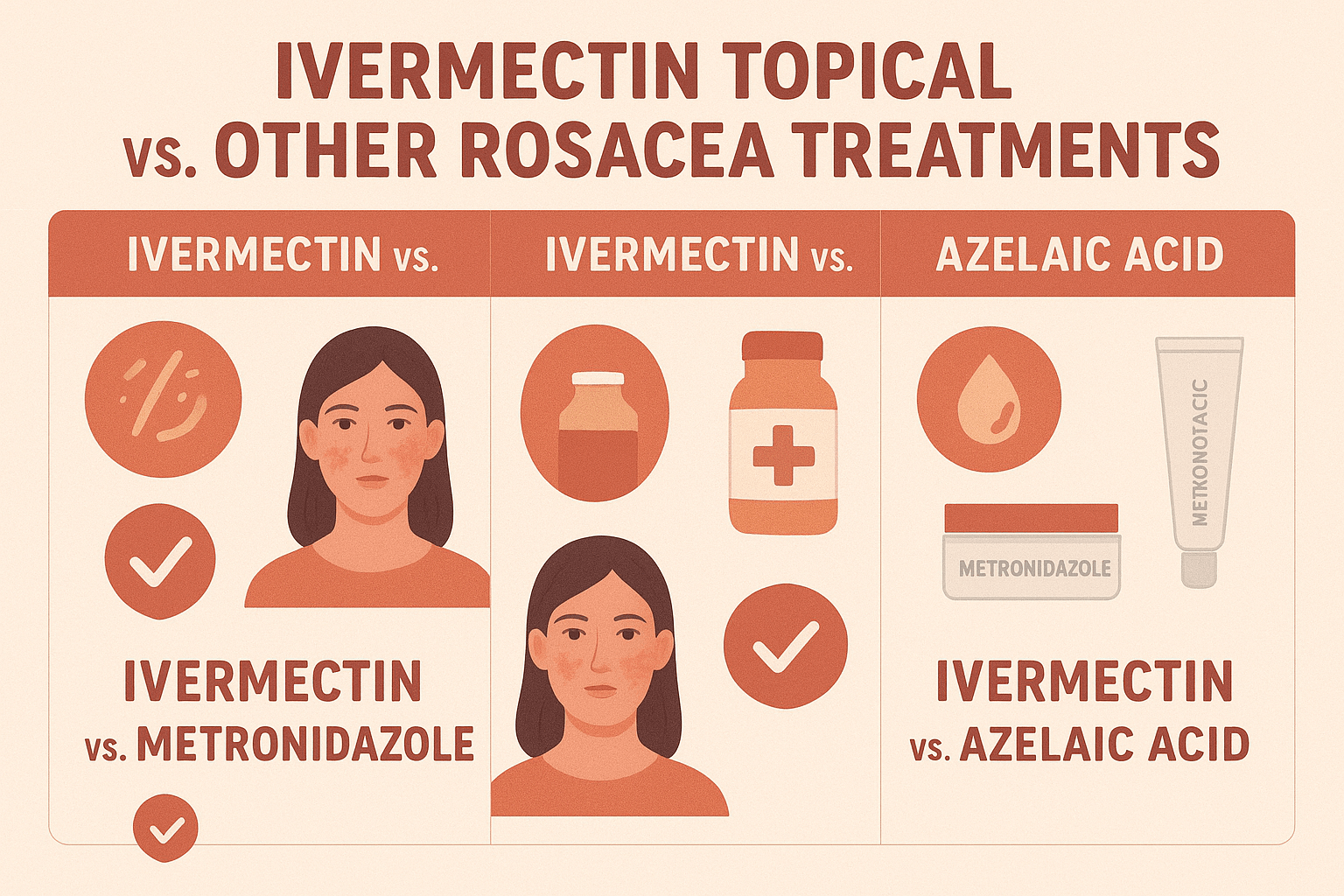
Ivermectin vs. Antibiotics
Unlike antibiotics, which mainly target bacteria, Ivermectin topical works by reducing Demodex mites and calming skin inflammation. This means:
- No risk of antibiotic resistance.
- Targets the root causes of rosacea rather than just masking symptoms.
- Provides gentle, long-lasting relief for sensitive skin.
Why Ivera Cream: Offers all the benefits of ivermectin with consistent quality and faster visible results, making it a superior alternative to long-term antibiotic use.
Ivermectin vs. Metronidazole
Both metronidazole and ivermectin creams are effective for rosacea. But studies show:
- Ivermectin cream often works faster, reducing redness and bumps within weeks.
- It provides longer-lasting remission, so flare-ups are less frequent.
- Gentle on sensitive skin and suitable for daily use.
Why Ivera Cream: Gives patients the same or better results than metronidazole, with easier application and improved comfort.
Ivermectin vs. Azelaic Acid
Azelaic acid is commonly used to reduce redness. However:
- Some patients find it less effective on papules and pustules.
- Can cause mild irritation or dryness in sensitive skin.
Why Ivera Cream: Reduces redness and bumps while keeping skin smooth and hydrated, making it a more complete solution for rosacea management.
End Result :
When comparing treatments, Ivermectin topical creams like Ivera Cream combine fast results, gentle care, and long-lasting relief. It addresses the root causes of rosacea while being safer and more comfortable than antibiotics, metronidazole, or azelaic acid.
Clinical Studies on Ivermectin for Rosacea
Evidence From Randomized Trials
Multiple clinical trials have shown that ivermectin 1% cream is highly effective in reducing rosacea bumps and redness. Compared to placebo or metronidazole, ivermectin topical treatments consistently provide faster and more noticeable improvements.
| Study Focus | Treatment | Outcome |
| Papulopustular Rosacea | Ivermectin 1% Cream (including Ivera Cream) | Significant reduction in bumps and redness within 4 weeks |
| Comparative Trial | Metronidazole 0.75% Cream | Improvement slower, higher relapse rates |
| Long-Term Use | Ivermectin 1% Cream | Sustained results over 12–16 weeks, high patient satisfaction |
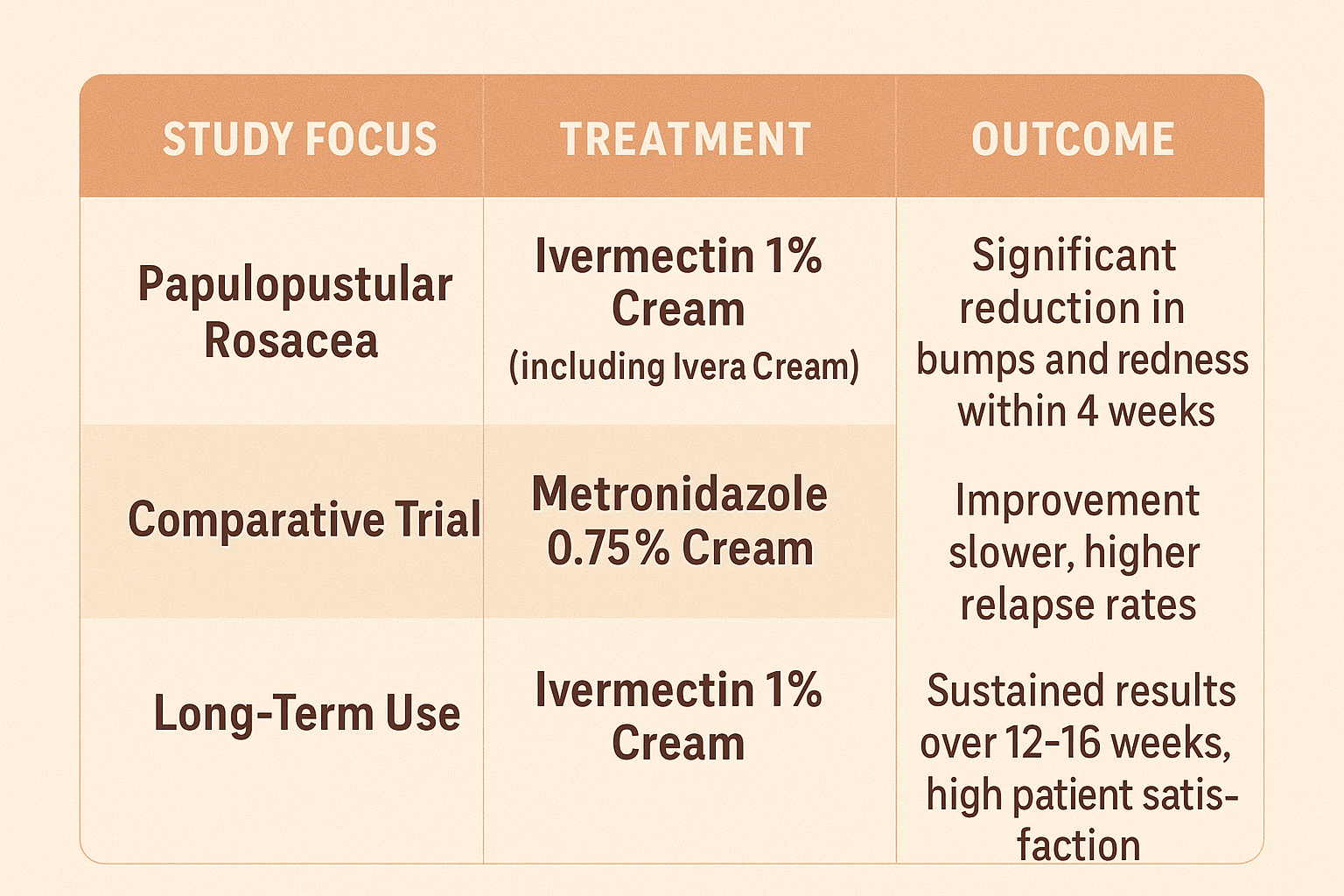
Long-Term Outcomes
Patients using ivermectin topical consistently show sustained improvement over months. The cream not only reduces flare-ups but also helps maintain smoother, calmer skin long-term.
Real-World Patient Data
Dermatologists report increasing satisfaction among patients switching to ivermectin creams like Ivera Cream. Patients often notice reduced redness, fewer bumps, and overall better skin quality, leading to improved confidence.
Why More Patients Are Switching to Ivermectin Creams
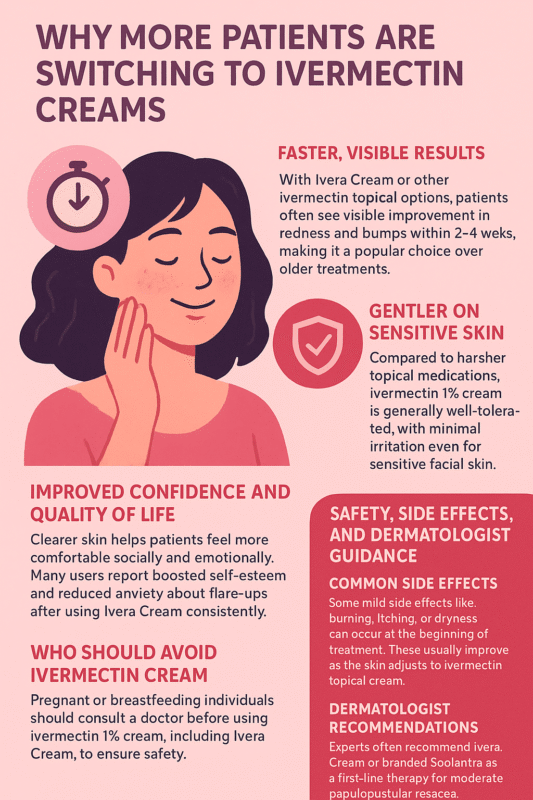
Faster, Visible Results
With Ivera Cream or other ivermectin topical options, patients often see visible improvement in redness and bumps within 2–4 weeks, making it a popular choice over older treatments.
Gentler on Sensitive Skin
Compared to harsher topical medications, ivermectin 1% cream is generally well-tolerated, with minimal irritation even for sensitive facial skin.
Improved Confidence and Quality of Life
Clearer skin helps patients feel more comfortable socially and emotionally. Many users report boosted self-esteem and reduced anxiety about flare-ups after using Ivera Cream consistently.
Safety, Side Effects, and Dermatologist Guidance
Common Side Effects
Some mild side effects like burning, itching, or dryness can occur at the beginning of treatment. These usually improve as the skin adjusts to ivermectin topical cream.
Who Should Avoid Ivermectin Cream
Pregnant or breastfeeding individuals should consult a doctor before using ivermectin 1% cream, including Ivera Cream, to ensure safety.
Dermatologist Recommendations
Experts often recommend Ivera Cream or branded Soolantra as a first-line therapy for moderate papulopustular rosacea. Its dual action against Demodex mites and inflammation, along with excellent patient tolerance, makes it a preferred choice for long-term rosacea management.
Conclusion: Why Choose Ivera Cream
- Targets root causes: Reduces Demodex mites and inflammation.
- Fast results: Visible improvement in 2–4 weeks.
- Gentle on skin: Suitable for sensitive faces.
- Affordable & reliable: Same benefits as Soolantra at lower cost.
- Boosts confidence: Helps you feel comfortable and happy in your skin.

